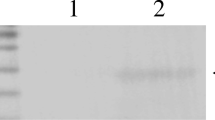Abstract
Bacterial ghosts (BGs) are gram-negative bacteria cell membranes without cytoplasmic content obtained by lysis as a result of cell-wall perforation mediated by the φX174 bacteriophage E protein. Introducing into a lytic plasmid lysis gene from other bacteriophages, which target alternative molecular targets, in addition to the E protein gene of bacteriophage φX174, can lead to an increase in the efficiency of lysis and, in some cases, to an increase in the immunogenicity of preparations. Escherichia coli strains carrying plasmids with various combinations of genes encoding protein E of phage φ174 with cassettes of lytic genes of the “choline–endolysin” systems of phages λ or L-413C, providing different degrees of destruction of the cell wall, were obtained for the subsequent selection of the most promising lytic structures. The formation of E. coli ghosts and the release of cell contents was confirmed by transmission electron microscopy. When the cultivation temperature was increased from 28 to 42°C, the lysis of E. coli cultures DH5α/pEYR'-E, DH5α/pEYR'-Y-K, DH5α/pEYR'-E-Y-K, and DH5α/pEYR'-E-Sam7-R-Rz was observed. Lysis was practically not detected during the growth of the DH5α/pEYR'-S-R-Rz culture, as in the control strain DH5α/pEYR'. The results of the analysis of ultrathin sections of BGs preparations by transmission electron microscopy (TEM) were comparable with the data on optical density and the results of inoculation of induced cultures of engineered strains, and also made it possible to assess the fine structure of bacterial cells carrying various combinations of lytic phage genes. BGs of gram-negative bacteria are promising for the creation of highly effective inactivated candidate vaccines that could replace currently available bacterial heat-inactivated and formol vaccines.



Similar content being viewed by others
REFERENCES
Young, R., Bacteriophage lysis: mechanism and regulation, Microbiol. Rev., 1992, vol. 56, pp. 430–481. https://doi.org/10.1128/mr.56.3.430-481.1992
Russel, M., Filamentous phage assembly, Mol. Microbiol., 1991, vol. 5, pp. 1607–1613. https://doi.org/10.1111/j.1365-2958.1991.tb01907.x
Bläsi, U., Linke, R.P., and Lubitz, W., Evidence for membrane-bound oligomerization of bacteriophage phi X174 lysis protein-E, J. Biol. Chem., 1989, vol. 264, pp. 4552–4558.
Eko, F.O., Witte, A., Huter, V., Kuen, B., Fürst-Ladani, S., Haslberger, A., et al., New strategies for combination vaccines based on the extended recombinant bacterial ghost system, Vaccine, 1999, vol. 17, pp. 1643–1649. https://doi.org/10.1016/s0264-410x(98)00423-x
Hajam, I.A., Dar, P.A., Appavoo, E., Kishore, S., Bhanuprakash, V., and Ganesh, K., Bacterial ghosts of Escherichia coli drive efficient maturation of bovine monocyte-derived dendritic cells, PLoS One, 2015, vol. 10, pp. 1–15. https://doi.org/10.1371/journal.pone.0144397
Langemann, T., Koller, V.J., Muhammad, A., Kudela, P., Mayr, U.B., and Lubitz, W., The bacterial ghost platform system, Bioeng. Bugs, 2010, vol. 1, pp. 326–336. https://doi.org/10.4161/bbug.1.5.12540
Ebensen, T., Paukner, S., Link C., Kudela, P., de Domenico, C., Lubitz, W., et al., Bacterial ghosts are an efficient delivery system for DNA vaccines, J. Immunol., 2004, vol. 172, pp. 6858–6865. https://doi.org/10.4049/jimmunol.172.11.6858
Haidinger, W., Szostak, M.P., Jechlinger, W., and Lubitz, W., Online monitoring of Escherichia coli ghost production, Appl. Environ. Microbiol., 2003, vol. 69, pp. 468–474. https://doi.org/10.1128/aem.69.1.468-474.2003
Senevirathne, A., Hewawaduge, C., and Lee, J.H., Salmonella enterica serovar Enteritidis ghosts displaying a surface FliC adjuvant elicit a robust immune response and effective protection against virulent challenge, Vet. Microbiol., 2020, vol. 243, p. 108633. https://doi.org/10.1016/j.vetmic.2020.108633
Muhammad, A., Kassmannhuber, J., Rauscher, M., Falcon, A.A., Wheeler, D.W., Zhang, A.A., et al., Subcutaneous immunization of dogs with Bordetella bronchiseptica bacterial ghost vaccine, Front. Immunol., 2019, vol. 10, p. 1377. https://doi.org/10.3389/fimmu.2019.01377
Won, G., Hajam, I.A., and Lee, J.H., Improved lysis efficiency and immunogenicity of Salmonella ghosts mediated by co-expression of λ phage holin-endolysin and ɸX174 gene E, Sci. Rep., 2017, vol. 7, p. 45139. https://doi.org/10.1038/srep45139
Taylor, A., Kedzierska, S., and Wawrzynow, A., Bacteriophage λ lysis gene product modified and inserted into Escherichia coli outer membrane: Rz1 lipoprotein, Microb. Drug Resist., 1996, vol. 2, p. 147. https://doi.org/10.1089/mdr.1996.2.147
Garcia, E., Chain, P., Elliott, J.M., Bobrov, A.G., Motin, V.L., Kirillina, O., et al., Molecular characterization of L-413C, a P2-related plague diagnostic bacteriophage, Virology, 2008, vol. 372, pp. 85–96. https://doi.org/10.1016/j.virol.2007.10.032
Witte, A., Blaësi, U., Halfmann, G., et al., Phi X174 protein E-mediated lysis of Escherichia coli, Biochimie, 1990, vol. 72, pp. 191–200. https://doi.org/10.1016/0300-9084(90)90145-7
Maniatis, T., Fritsch, E.F., and Sambrook, J., Molecular Cloning: a Laboratory Manual, Cold Spring Harbor, NY: Cold Spring Harbor Laboratory Press, 1982.
Chang, A.C. and Cohen S.N., Construction and characterization of amplifiable multicopy DNA cloning vehicles derived from the P15A cryptic miniplasmid, J. Bacteriol., 1978, vol. 134, pp. 1141–1156. https://doi.org/10.1128/jb.134.3.1141-1156.1978
Jechtlinger, W., Szostak, M.P., Witte, A., and Lubitz, W., Altered temperature induction sensitivity of the lambda pR/cI857 system for controlled gene E expression in Escherichia coli, FEMS Microbiol. Lett., 1999, vol. 173, pp. 347–352. https://doi.org/10.1111/j.1574-6968.1999.tb13524.x
Dentovskaya, S.V., Vagaiskaya, A.S., Platonov, M.E., Trunyakova, A.S., Kotov, S.A., Krasil’nikova, E.A., et al., Peptidoglycan-free bacterial ghosts confer enhanced protection against Yersinia pestis infection, Vaccines, 2022, vol. 10, no. 1, p. 51. https://doi.org/10.3390/vaccines10010051
Bahr, G.M. and Chedid, L., Immunological activities of Muramyl peptides, Fed. Proc., 1986, vol. 45, pp. 2541–2544.
Funding
This study was supported by the Russian Science Foundation, project no. 19-15-00072.
Author information
Authors and Affiliations
Corresponding author
Ethics declarations
Conflict of Interest
The authors declare that they have no conflicts of interest.
Additional information
Translated by A. Kazantseva
About this article
Cite this article
Platonov, M.E., Vagaiskaya, A.S., Trunyakova, A.S. et al. The Efficiency of Bacteriophage Lytic Enzymes in the Course of Bacterial Ghost Generation. Mol. Genet. Microbiol. Virol. 37, 131–137 (2022). https://doi.org/10.3103/S0891416822030077
Received:
Revised:
Accepted:
Published:
Issue Date:
DOI: https://doi.org/10.3103/S0891416822030077




